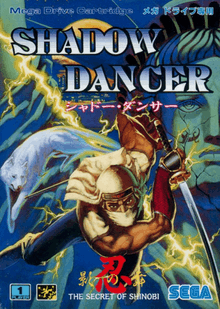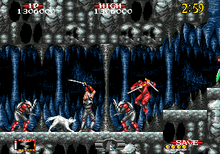Shadow Dancer: The Secret of Shinobi
| Shadow Dancer: The Secret of Shinobi | |
|---|---|
 Japanese cover art | |
| Developer(s) | Sega |
| Publisher(s) | Sega |
| Designer(s) | Tomohiro Kondo |
| Artist(s) | Hiroyuki Kawaguchi Rieko Kodama |
| Composer(s) | Keisuke Tsukahara |
| Series | Shinobi |
| Platform(s) | Sega Genesis, Virtual Console, Windows |
| Release date(s) | December 1, 1990 |
| Genre(s) | Platform game, hack and slash |
| Mode(s) | Single player |
| Distribution | Cartridge, online distribution |
Shadow Dancer: The Secret of Shinobi (シャドー・ダンサー ザ・シークレット・オブ・シノビ) is a side-scrolling action game produced by Sega that was originally released for the Mega Drive/Genesis in 1990. It has been re-released via downloading services such as the Wii's Virtual Console and Steam, and included in the Sega Genesis Collection for the PlayStation 2 and PlayStation Portable but it was omitted in PAL version (Sega Mega Drive Collection).
It is the second game in the Shinobi series released for the Mega Drive following The Revenge of Shinobi. However, it is not a continuation of the previous game, but rather a loose adaptation of the arcade game Shadow Dancer.[1] Like in the original arcade game, the player controls a ninja followed by a canine companion.
Gameplay

The game mechanics are roughly identical to the arcade version, with the main difference is the addition of a meter for the ninja dog that accompanies the player. In order for the dog to attack an enemy, the player must hold down the attack button until the meter is filled. The dog will only attack when he is barking towards a nearby enemy. This allows the player to sic the ninja dog on an enemy while standing and jumping, allowing for more versatility than in the arcade version (where the dog only attacked while the player was crouching). The objective of each stage is also slightly changed from retrieving time bombs to rescuing hostages, much like in the original Shinobi arcade game. The male hostages give out bonus points and the occasional extra life, while the female hostages will strengthen the player's basic attacks until he reaches the next stage or loses a life.
While the one-hit-point-per-life system from the two arcade version has been retained, there are numerous bonus lives hidden throughout the game. Between rounds the player will participate in a bonus stage where he will jump down from a building and shoot down an army of 50 enemy ninjas jumping across his direction. After the bonus stage ends, the player will gain a certain amount of points or extra lives.
There are three difficulty settings in the game, each affecting the enemy placement and the number of continues the player gets. The player can also choose to disable shurikens, using them only for boss battles and bonus stages. Bonus points are awarded at the end of each stage and boss battle (except for the final stage), based on how long it took the player to complete the stage and whether a ninjutsu attack was used or not. There are also hidden bonuses that the player can achieve by completing a stage or boss battle under a certain condition.
Plot
In 1997, an evil group called "Union Lizard" has taken over New York City, turning most of the city in ruins. The few citizens who survived Union Lizard's onslaught of chaos are now kept prisoners by its members. A ninja warrior, accompanied by his faithful dog Yamato (大和), emerges from hiding to combat Union Lizard's reign and rescue the hostages. The identity of the protagonist, which is kept ambiguous in the in-game opening, varies between supplemental materials. The Japanese manual identifies him as Hayate (疾風), son of Joe Musashi from the previous games in the Shinobi series,[2][3] while the English language manual identifies him as Joe Musashi himself coming out of retirement.[4] The names of the enemy bosses are also different between versions.[5]
There are five rounds in all. The first four rounds consists of three stages each, with the third one being a confrontation with the round's boss, while the fifth round consists of only one stage comprises five rooms that leads to the final boss' lair. The rounds are as followed:
- Round 1: "Burning Downtown" - Set in the ruins of a city filled with burning buildings. The boss is called the Stomper (鎧 Yoroi, "The Armor"), a giant armored warrior who can cause earthquakes by stomping the ground, as well as shoot fireballs.
- Round 2: "Battle in the Railway" - Loosely based on Round 2 from the arcade version. Set on a bridge which leads to a railway. The boss is called the Mirage (壁 Kabe, "The Wall"), a brick wall possessed by a demon that can materialize into a face with a pair of arms.
- Round 3: "The Statue of Liberty" - Set on a construction site which leads to an elevator ride to the top of the Statue of Liberty. The boss is called Blade (刃 Yaiba), a giant armour clad-woman armed with rolling buzzsaws on both of her hands.
- Round 4: "In the Darkness" - Loosely based on Stage 4-1 from the arcade version. Set inside a dark cave. The boss is the Wheel of Fire (車火 Kurumabi), a flying spinning wheel with three fire-breathing faces.
- Round 5: "Union Lizard" - Set in the hideout of the enemy, where the player proceeds through a series of six rooms, each populated by a specific enemy type. The sixth room is the lair of the final boss Sauros (unnamed in the Japanese version), who will summon his minions of black ninjas to attack the player.
Reception
| Reception | ||||||
|---|---|---|---|---|---|---|
| ||||||
Shadow Dancer: The Secret of Shinobi was well received. Mega placed it at #33 in their ranking of top Mega Drive games of all time.[7] In 2008, Joystiq called The Secret of Shinobi "the most awesome release" in the entire Shinobi franchise, adding that the game "answers the question of what could possibly be cooler than a ninja stalking around a gritty urban landscape: that ninja's dog."[8] According to a Virtual Console review by Nintendo Life in 2010, "this title comes highly recommended to all ninja fans."[9]
See also
References
- ↑ The next game in the series, Shinobi III: Return of the Ninja Master, serves as the sequel to The Revenge of Shinobi. Both games were released under the "Super Shinobi" name.
- ↑ "Shadow Dancer at Sega of Japan's Virtual Console website" (in Japanese). Sega.
- ↑ Sega. "Shadow Dancer" (in Japanese). Mega Drive. Level/area: Instruction manual, pages 3-7.
- ↑ Sega. "Shadow Dancer". Genesis. Level/area: Instruction manual, page 2.
- ↑ The names of the bosses are listed with their English version names first, followed by their names in the Japanese version in parentheses.
- ↑ "Shadow Dancer for Genesis". GameRankings. Retrieved 2013-12-22.
- ↑ Mega (1): 76. October 1992. Missing or empty
|title=(help) - ↑ Virtually Overlooked: Shadow Dancer: The Secret of Shinobi, Joystiq, Feb 7th 2008.
- ↑ Calvert, Darren (8 January 2010). "Shadow Dancer: The Secret of Shinobi (Wii Virtual Console/Mega Drive) Review". Nintendo Life. Retrieved 2014-09-01.
External links
- Shadow Dancer on Steam
- Shadow Dancer at GameFAQs
- Shadow Dancer: The Secret of Shinobi at MobyGames
- Shadow Dancer: The Secret of Shinobi at GiantBomb
| ||||||||||||||||||||||||||